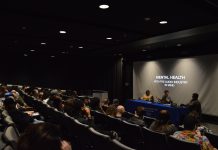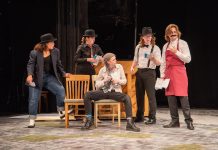Less than one year after he was told he would never walk again, Bill DeArmond hitchhiked toward Lindbergh Boulevard. He had just arrived at Lambert Airport on a clear and sunny day in September, 1968. He was wearing the only clothes he had with him – his Army dress uniform. A passing insurance salesman offered him a ride to a Ladue Elementary School where his mother was a teacher. He wanted her to know he was home and had survived the Vietnam War.
“I had to keep pinching myself. It was so soon and sudden,” DeArmond said. “Cause we were in the field in Vietnam just (a couple of days before) and then we’re all of a sudden home.”
DeArmond is a 1972 Webster College graduate. He attended Webster as part of a program designed for returning Vietnam veterans called Veterans’ Accelerated Urban Learning for Teaching (VAULT). He started in the program in 1969.
After changes to Webster College policies in 1968, male students were accepted for the first time in all departments. That same year, the VAULT program was established. The pilot program was designed to train returning Vietnam veterans to become teachers, specifically in the inner-city schools.
VAULT was initiated six years before Webster formally began a partnership with the Department of Defense to offer classes directly on military bases in 1974. Currently, courses are offered on 39 U.S. military installations and additional outlets around the world.
The first class, made up of 42 veterans’ ages 20 through 45, began on Monday, June 24, 1968, according to a Webster archival document. Upon graduation from the program, the veterans would have earned a bachelor’s degree and teaching certification.
Sister Barbara Ann Barbato said she remembers VAULT as one of her favorite programs at Webster. She taught at Webster College from 1963 until her retirement in 2003. To prepare for her teaching, Barbato earned a doctorate in Modern European History and Asian Studies from Saint Louis University. During her time at Webster, she was the director of Individualized Studies, Dean of Students. She was awarded the William T. Kemper Award for Excellence in Teaching, and upon her retirement, Professor Emerita.
Barbato said the program was “the kind of thing that crossed a lot of experiences” in relation to her life, such as, teaching of teachers, curriculum development, people in the inner city, cultural anthropology and the military because her father had served in World War II. She said all of those things came together in the VAULT program.
“The program brought together all these little strings I had in my life and as a result I had a greater interest in what happened to it,” Barbato said. “I had a willingness to stick my nose in and say ‘Do you need any help?’ ‘Can I do this?’ or ‘Can you use me?’ That kind of thing.”
Barbato said the VAULT program built meaningful relationships between the inner city schools, Forest Park Community College, Webster and many other organizations and individuals. People from different communities came together to find solutions to a variety of problems. These problems included helping the returning veterans learn a trade and find jobs and filling teaching roles, especially in the inner city schools where there was a shortage of certified teachers and role models.
DeArmond joined the Army after graduating from Webster High School and marrying his high school sweetheart Rosemary, in 1966. He went to Vietnam in 1967 and served with the 2nd Ranger Battalion, 173rd Airborne Brigade. He worked as a radio operator and would call for elements, such as air strikes, artillery and medical evacuations. On Thanksgiving Day, 1967, during the battle of Dak To, he was wounded in a vehicle accident while traveling in a convoy.
The 20-year-old suffered a broken hip and a back injury. He was told he would never walk again and spent two-and-a-half months in a hospital located in Japan. However, he refused to accept the idea of being crippled the rest of his life.
“For weeks and weeks I just kept pulling myself out of bed. They were sticking pins in my feet, my legs – I had no feeling,” DeArmond recalls. “I just kept pulling myself out of bed and falling. The guys around me would keep picking me up and throwing me back in bed. But, slowly I started getting feeling and then started walking. It was scary.”
DeArmond’s wife Rosemary recalls waking up in middle of the night with a cramp in her leg while her husband was away in Vietnam. She explained the pain felt similar to a charley horse. The next morning, she told her sister she felt something had happened to her husband. Soon after, the Red Cross contacted her by phone and told her that DeArmond had been involved in an accident.
After recovering from his injuries, DeArmond went back to his unit in Vietnam. He was put on lighter duty and worked in a command bunker. He received his formal discharge from the Army in May of 1969.
DeArmond’s military service was ending, he was married and he needed a job. He said the injuries he sustained in Vietnam left him physically unable to pursue the goal he had always wanted – to own and operate a working farm. He was in need of a new career goal and learned about the VAULT program from his mother.
At the time, his mother was attending Webster College, earning a master’s degree and had heard about the new veterans program. He said both of his parents and other members of his family were school teachers, so the opportunity seemed like a good fit and came at the right time.
The 1970 archival document also states that a “second phase” of the program allowed the veterans to take part of their courses at Forest Park Community College. Also, more veterans were recruited from the St. Louis area to help with the cost of housing. The first VAULT class of returning veterans had been mainly recruited from Fort Leonard Wood.
Barbato taught an American history class at Forest Park during the VAULT program. She said many of the veterans came from a variety of diverse backgrounds and remembers having some of them in her classes.
“They were kind of quiet in the classroom in terms of relating to the other students. Not uncomfortably so, but just didn’t put themselves forward,” Barbato said. “They were just a tad bit older…they were just old enough to feel the difference in ages, I think. Or maybe it was taking the time to access the situation of where they fit in a classroom that was probably mostly girls in the beginning.”
After starting VAULT classes, DeArmond said the accelerated program was tough because it had been designed for veterans to obtain a four-year degree in only three-years. He attended day school, night school, and summer school and also worked as a teacher’s aide at Webster High School 15 hours a week.
“It really was all kind of a blur because I had to do it so intensively,” DeArmond said. “I just remember a lot of nights with almost no sleep studying for tests and getting papers ready.”
DeArmond said he was motivated because he was one of the few married veterans in the program. He and his wife had a baby boy while he was attending college. “So there was a definitely a little pressure to finish,” he said.
DeArmond remembers the VAULT directors well. He recalled Don White as a “nice fellow that really cared about the veterans” and Fred Stopsky as a “super-guy and incredible teacher.” He said they were “just very encouraging to all of us.”
After graduation, DeArmond taught for one year at a Webster Groves-area elementary school. In 1973, he began teaching in the Rockwood School District, primarily sixth grade, until his retirement in 1999.
Since his retirement from teaching, DeArmond volunteers his time in an effort to help other veterans. He is a member of the Vietnam

Veterans of America chapter 1028 (VVA) located in Fenton. The group works to give back to the community by engaging in elements, such as fund raising for veterans’ organizations, reaching out to veterans in need and making visits to area schools to offer insights and experiences from the Vietnam War.
“The VVA group has been good for (Bill.) He has really bonded with these men and they are really close nit,” Rosemary said. “It’s a worthwhile organization and they work hard to help other veterans.”
Archival records do not indicate when the VAULT program officially ended. Barbato said it is possible that by the mid-1970s the number of returning veterans was probably lower. And in 1974, Webster programs began to be offered directly on military bases at an invitation from the Department of Defense.
Barbato said it was not easy and it did not happen overnight, but VAULT lasted long enough that it was a good thing.
“It propelled movement in attitudes and seeing opportunities and finding other ways to assist people to build a better world than where they came into it,” she said.



